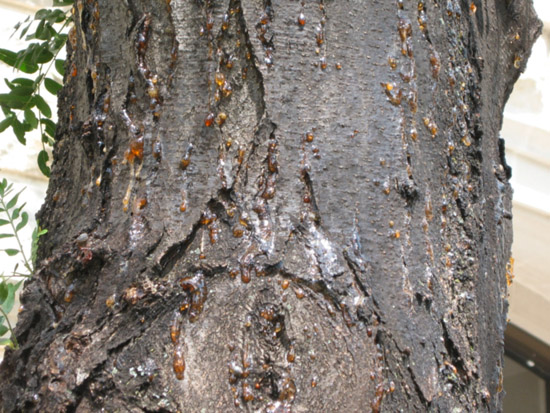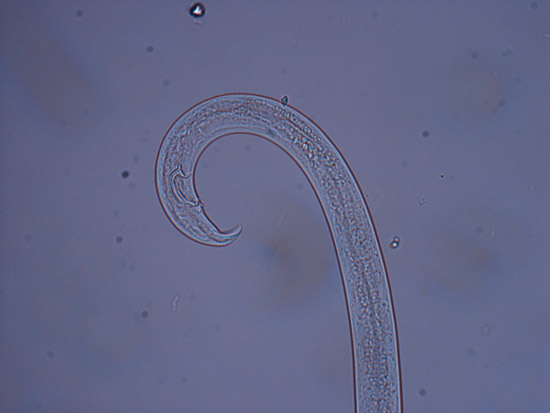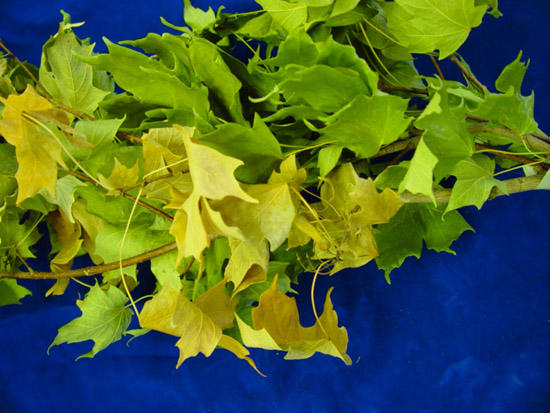Issue 1, April 16, 2012
Can Drought Stress of Tree and Shrubs = More Disease (and Other Problems)?
During the summer of 2011, large portions Illinois were subject to drought and below average precipitation. Central portions of the state were especially dry. During a drought, plants grown in landscapes often suffer stress due to an inadequate supply of available water. To alleviate this stress, homeowners often turn to the garden hoses and sprinklers. Unfortunately, we often focus our watering turf and herbaceous plants while neglecting trees and shrubs. This neglect can be costly as drought can have immediate and long term effects on the health of trees and shrubs.
Drought can have primary as well as secondary effects on trees. Primary effects occur as various plant tissues (roots, leaves, twigs, etc.) dry and become desiccated. This type of damage is commonly first observed as yellowing and browning along the margins of leaves and progresses towards the center of the leaves.
Secondary effects of drought stress occur as normal plant physiological functions are inhibited. In trees, drought stress can cause photosynthesis to cease, thereby hindering plant growth. Drought stress may also prevent the production of defensive chemicals, and could make the tree more susceptible to climate extremes (sunscald, frost crack from winter injury, and high winds). Trees may also be more sensitive to pesticide injury, phytotoxicity, salts from deicing, construction damage, insects, animals, and nutrient competition.
Drought is more likely to affect trees that are newly transplanted, planted in a poor site or location (clay soils or limited space), consist of a poor root system (rotted roots or girdled roots), planted improperly (too deep), have a mechanical injury (lawn mower or construction), known to have a shallow root system (conifers, maples, honey locust, and London plane), or smaller tree species (dogwood, redbud, or crabapples).
Overall, drought can cause a tree to decline and, in turn, predispose trees to disease. There are many disease pathogens that will take advantage of trees under stress. Here are a few examples:
Fungal Cankers

Unknown canker on honey locust, Picture taken by Bill Bolt
Canker diseases are fairly common on stressed honey locust trees. Research has shown that honey locust cultivars vary in susceptibility to the canker fungi. Look for resistance ratings when purchasing new honey locust trees. The disease has been linked to drought stress in many cases. Where tree selection is not a choice, avoid injury, provide water in periods of drought stress, and help tree vitality by removing dead wood and fertilizing in the spring. As with most canker diseases, there is no rescue treatment that can be sprayed on the tree. When you see a canker problem, try to determine the cause of stress and take measures to alleviate that stress.
Dutch elm disease
Drought-stressed elm trees are more attractive to the elm bark beetle, which may carry the Dutch elm disease fungus. With Dutch elm disease you will want to watch for yellowing of the leaves, followed by wilting and browning. Often this happens so quickly that the problem is first noticed when branches with brown leaves appear in the canopy seemingly overnight. A single branch will usually show symptoms first (called flagging), with rather rapid spread to adjacent branches and the entire tree. Look for vascular discoloration to help with diagnosis of this disease. DED will cause a streaking of the sapwood. Peel back the bark of a symptomatic branch to reveal the brown streaks in the otherwise tan outer sapwood. It is generally too late to save a tree once it is infected, but an accurate diagnosis of the problem may help save nearby elm trees.Pine wilt nematode

Picture of a Pine wilt nematode (Bursaphelenchus xylophilus)
Pines under drought stress lack the ability to make resins to protect against pinewood nematodes and pine wilt disease. Pine wilt symptoms to watch for are gray-green foliage or needles that appear dull or off-color. The tree will not improve. Instead, as the summer progresses, the foliage will turn yellow and then brown and remain attached for a long time. Trees that were infected last fall may not develop any new growth this spring. Although eventually the entire tree will be affected, initial symptoms may appear on one branch or area of the tree. Pine wilt occurs on any of the pines we grow in Illinois except for white pine. There is no cure for a tree infested with pinewood nematodes. Trees confirmed to be infected trees should be removed as soon as possible. Debris from the infested tree should be removed and burned or buried.
Verticillium wilt

Verticillium wilt symptoms on a maple
Symptoms of Verticillium wilt are more pronounced in drought, in part because drought inhibits the trees ability to wall off the fungus. Symptoms include wilt, branch death, and quick decline of plants. Hundreds of plant species, including trees, shrubs, groundcovers, vines, vegetables, fruits, herbaceous ornamentals, and flowers may become infected. Some trees that are frequently infected by this disease are maple, ash, and elm. We see symptoms throughout the growing season. Peel off some of the bark on a symptomatic branch and look for staining of the wood in distinct streaks of brown, dark green, or yellow-green wood. Verticillium-infected ash trees do not always show staining. There is no cure for Verticillium wilt. Still, there are many cultural and preventive strategies to manage the disease and help infected trees live with the fungus. Always start with healthy plants and avoid susceptible species. Supply balanced fertilization and provide adequate irrigation to improve the health of stressed plants.
The U of I Plant Clinic can test for diseases such as Dutch elm disease, pinewood nematodes, and Verticillium wilt. For Dutch elm disease and Verticillium, samples should be alive, showing vascular streaking, thumb-thick, and 8 to 10 in. long. If you want to test ash for Verticillium wilt in ash, you will need to be sure to submit branch petioles for testing. The cost for DED and Verticillium testing is $15.
Branch samples submitted to the U of I Plant Clinic for Pine wilt should be 1 to 2 inches in diameter and long enough to put into a vise so that wood discs can be cut from both ends of the branch. This nematode is not uniformly distributed within a tree. We find that the most reliable samples are from branches that have brown needles still attached. The cost for Pine wilt testing is $20.
For additional information, please refer to the U of I Plant Clinic website: http://web.extension.illinois.edu/plantclinic/index.cfm (Stephanie Porter and Travis Cleveland)
Authors:
Stephanie Porter
Travis Cleveland